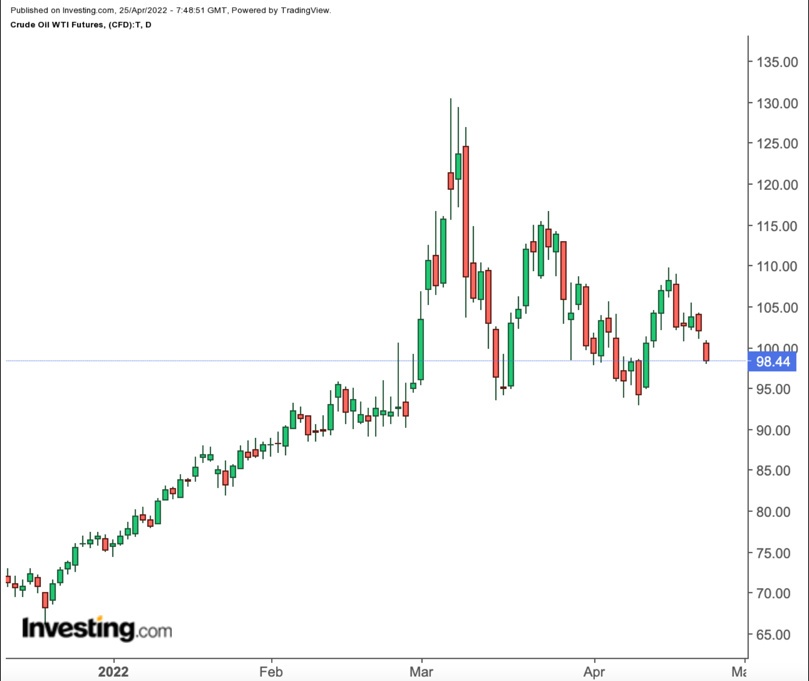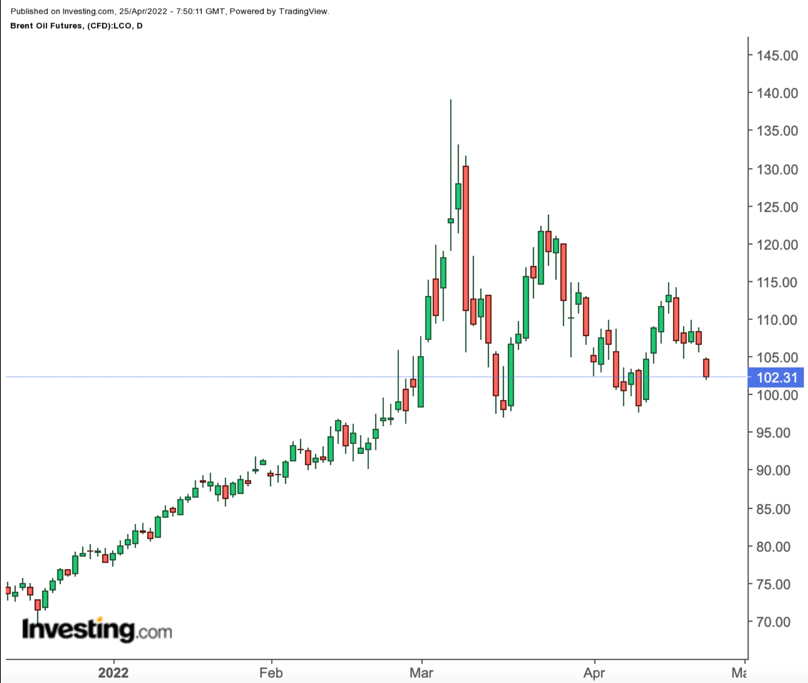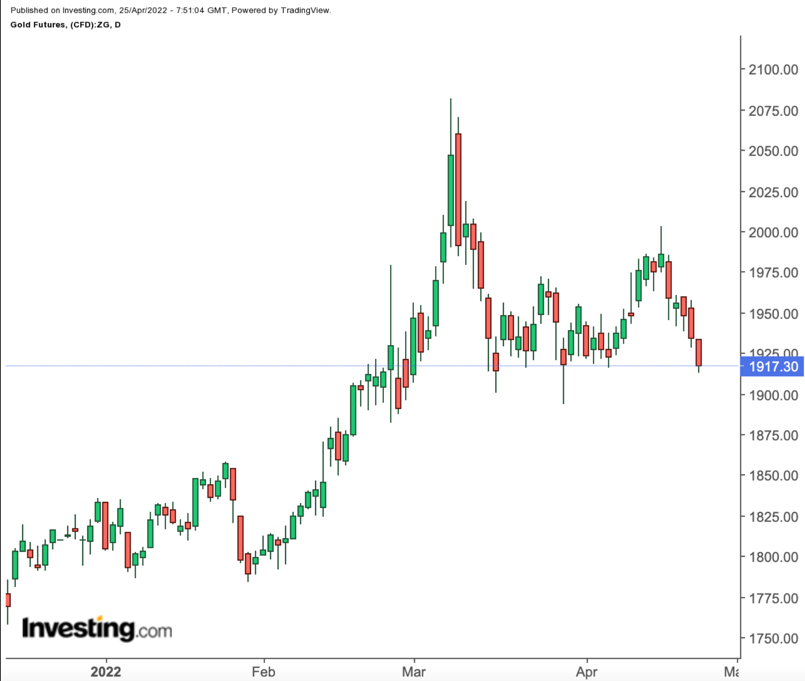Nvidia and TSMC to unveil first domestic wafer for Blackwell chips, Axios reports
China is expected to flex more of its muscle as an economic power and anti-COVID crusader this week, adding to the downward pressure across commodities, particularly in oil prices, much to the ire of OPEC+.
As Shanghai’s lockdown officially marks its fourth week, with no signs that the financial hub and its weary population of 28 million will emerge soon from the government’s restrictions, analysts are expecting a slump in energy demand due to limited mobility in the city.
As a new trading week began in Asia, New York-traded West Texas Intermediate (WTI) fell below $100 a barrel, in what’s become a familiar downside risk level for US crude in times of serious demand concerns. And the continued lockdown of the second largest city in the world’s No. 2 economy and No. 1 oil importer, certainly suggests heightened demand concerns.
By 1:00 PM in Singapore (1:00 AM in New York), WTI crude in New York was down $3.17, or 3.1%, at $98.90 per barrel. That came on top of last week’s 4.5% slide in the US crude benchmark.
London-traded Brent, the global benchmark for oil, remained above $100 but was not high enough to provide comfort. Brent was down $3.29, or 3.1%, at $102.86, after a 4.5% tumble last week, just like WTI.
Oil’s latest slide came after Bloomberg reported last week that China’s demand for gasoline, diesel and aviation fuel in April is expected to be 20% lower than a year ago.
That would be equivalent to a drop in crude oil consumption of 1.2 million barrels a day, it said, and will be the largest hit to demand since the 2020 lockdown in Wuhan—the Chinese city where COVID-19 was first reported.
Besides that, the IMF and banks including UBS, Bank of America, Barclays and Nomura last week downgraded their 2022 growth forecasts for China. Nomura’s forecast was especially pessimistic, just 3.9%, which would mark China’s slowest growth rate since 1990—apart from 2020, when the pandemic derailed the global economy.
Despite year-on-year growth of 4.8% in the first quarter, economists said storm clouds were on the horizon as retail sales, a key indicator of economic health, fell 3.5% in March compared with the same period last year.
But many in Shanghai are also fighting back against Beijing’s notorious reputation for disinformation during the two-year long pandemic, its obsession for secrecy and a desire to control the narrative at all costs.
Since the Shanghai clampdown began on Mar. 28, memories of a China mired in the pandemic catastrophe of 2020 have weighed in varying degrees on oil price sentiment, even as the EU-Russia face-off over Ukraine suggests crude prices have little way to go but up.
What also bothers many is President Xi Jinping’s intent to enforce virus control measures long after the rest of the world has moved on from the pandemic.
China’s COVID death numbers—at under 40 as of the weekend—haven’t helped in strengthening the government’s case.
By comparison, South Korea—with a superior vaccination rate—reported a death rate of about 0.12% during its most recent wave. Applying the same fatality rate to China would translate to about 660 deaths.
Some health experts quoted in international media have fingered Chinese authorities’ long-standing practice of focusing on underlying causes of death such as cancer and heart disease. Others question whether Beijing is intentionally distorting the picture to save face after expending so much political capital claiming its response to the pandemic has been superior to that of the West.
Undeterred by the criticism, China pushed forth with its narrative as the new week began.
"The risk of continued and hidden transmission is high, and the situation is grim," Tian Wei, an official of Beijing's Municipal Party Committee, told a press briefing over the weekend.
Reports are already coming in of empty shelves at stores in and around Shanghai as people began hoarding essentials, a practice similar to the height of the 2020 COVID crisis.
In Beijing's eastern district of Chaoyang, with a population of around 3.45 million people, testing will be expanded. Everyone living or working in the area must take three COVID-19 tests this week. The district also announced that it had indefinitely banned extracurricular in-person classes or sports activities.
All these explain the fresh battering taken by oil prices on Monday.
Oil isn’t just dealing with the China COVID scare. Downward revisions to global growth by the IMF last week, along with the prospect of aggressive rate hikes by the Federal Reserve through 2022 to contain runaway US inflation is also weighing on oil as well as other major risk-assets, including stocks on Wall Street.
Oil bulls and particularly OPEC+, the global alliance of crude exporters, point to the upcoming US summer driving season and the war in Ukraine and the ever-increasing threat of a complete Western ban on Russian oil at some point, as factors that will likely keep world supply precariously low.
Russia is Europe's top gas supplier and the world's second-biggest oil exporter after Saudi Arabia.
"Oil prices are not expected to fall below $90 a barrel due to the prospect of a potential ban by the European Union on Russian oil,” Hiroyuki Kikukawa, general manager of research at Nissan Securities, said in comments carried by Reuters.
Morgan Stanley raised its third-quarter price forecast for Brent by $10 per barrel to $130 citing a "greater deficit" this year due to lower supply from Russia and Iran, which is likely to outweigh short-term demand headwinds.
In the case of gold, the front-month June futures contract on New York’s COMEX was down $16.35, or 0.9%, at 1,917.95 an ounce.
June gold lost 2% last week in an unexpected slide after its upward swing on Monday to a six-week high of $2,003.
Gold slid as the Dollar Index hit a more than two-year high of 101.34 on Friday while the benchmark 10-year Treasury yield neared December 2018 highs.
Friday’s liquidation in commodities came from tough rate hike language that was started early in the week by an array of Fed officials—including James Bullard and Mary Daly, who head the central bank’s St. Louis and San Francisco divisions, respectively—and was echoed toward the end of the week by Chairman Jerome Powell himself.
All were pushing for a 50-bps, or half percentage point, hike at the Fed’s next policy meeting set for May 4-5 after the mere 25 bps increase in March. Bullard was even suggesting a 75 bps hike at some point, saying the Fed was way behind the curve in fighting inflation that showed no sign of retreating from 40-year highs.
“Some fear that a 50 basis point rate increase will be the first of many and could slow down the economy and the demand for oil,” said Phil Flynn, energy analyst at Price Futures Group in Chicago.
“It is not just a tightening cycle upsetting traders overnight but also the pricing in of a 50-basis point interest rate increase by September by the European Central Bank," added Flynn.
"The Bank of Japan on the other hand wants to remain dovish but worries that the course of the U.S. and Europe could force them to change course.”
Fawad Razaqzada, an analyst at StoneX’s City Index, concurred with Flynn. Explaining:
"We won’t be hearing much from Fed speakers in the next couple of weeks as we enter the blackout period ahead of the central bank’s May 4 meeting. But the damage has already been done and the message has been loud and clear: US Federal Funds Rate will most likely rise by 50 basis points at that meeting.”
Investors across markets will be looking out for preliminary US first-quarter economic data on Thursday, with gross domestic product growth for the period likely to slow to 1.1% from 6.9% in the fourth quarter of 2021 due to the Omicron wave of the pandemic at the start of the year.
That will be followed on Friday by the Personal Consumer Expenditures Index, which is the Fed’s preferred inflation gauge. The last reading of the PCE Index showed inflation at 6.4% in the year to February, keeping to its fastest expansion in four decades.
Disclaimer: Barani Krishnan uses a range of views outside his own to bring diversity to his analysis of any market. For neutrality, he sometimes presents contrarian views and market variables. He does not hold positions in the commodities and securities he writes about.
